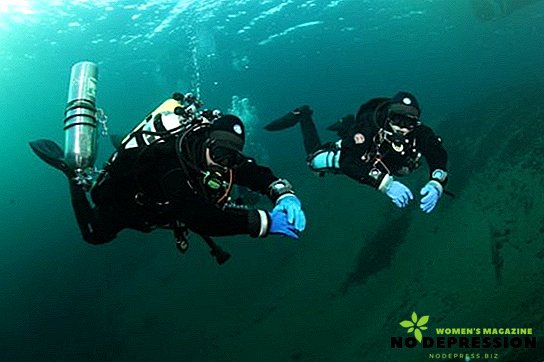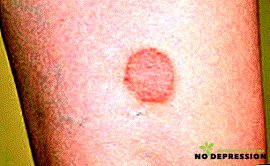In the world there are so-called occupational diseases, which are characteristic of people engaged in a particular activity. Caisson disease is one of them, which develops mainly among divers due to the violation of decompression conditions (a smooth transition from high atmospheric pressure to low).

The essence of pathology and its causes
First you need to figure out what constitutes a caisson disease. This pathology is better known as decompression sickness. It occurs as a result of changes in the concentration of gases that dissolve in the blood with a decrease in atmospheric pressure.
To learn more about the mechanism of the onset of pathology, it is desirable to consider a specific situation.
When immersed under water, a large load begins to be exerted on the human body, since the pressure increases significantly as the depth increases.
A lot of water presses on the human body, accelerating the dissolution of gases in the blood. And when lifting from the depth, especially in the case of a long stay under water, the pressure begins to fall sharply. This is the main factor triggering caisson disease.
As the load decreases, the dissolved gases begin to form bubbles, the concentration of nitrogen especially noticeably increases. These vesicles block the vessels and cause partial destruction of tissues. This leads to decompression. Also, sudden jumps in pressure can lead to changes in the vascular system of a neurological nature, especially this will affect the organs of hearing.
Caisson disease is called the disease of divers because of the increased risk of its occurrence among water lovers. However, miners, workers of pressure chambers, builders of bridges, military and so on are subject to pathology.
 When being under compressed air, and then with a sharp decrease in pressure, decompression sickness appears. Divers have a scheme for the normalization of pressure. With periodic supply of pure oxygen, gas bubbles can be prevented.
When being under compressed air, and then with a sharp decrease in pressure, decompression sickness appears. Divers have a scheme for the normalization of pressure. With periodic supply of pure oxygen, gas bubbles can be prevented.
One should not overlook the unforeseen situations, for example, the accidental depressurization of the aircraft cabin at high altitude. Artificially increased pressure decreases, and a person begins to experience pressure on the vessels as a result of the creation of natural conditions. It is precisely this that the ascents to the mountains are dangerous because they can cause hypoxia. The following factors also increase the risk of caisson disease:
- age;
- stress;
- excess weight;
- serious exercise on the body.
Classification and symptoms.
Symptoms of caisson disease may appear when the pressure changes or some time after that. Sudden attacks are very dangerous because they are swift and severe. Decompression sickness is characterized by the following symptoms:
- congestion in the ears;
- pain in different parts of the body;
- aching joints;
- heart rhythm disorder;
- respiratory dysfunction;
- skin rash;
- itching;
- severe headache and so on.
They may appear differently in each case. The disease can begin rapidly, immediately after lowering the pressure. However, this rarely happens. Basically, the first symptoms are pronounced and are determined by general malaise.
There are three main stages of the disease, which differ in the degree of symptoms:
- Lightweight Hypoxia appears, the gas begins to put pressure on the nerve ligaments. As a result of their irritation, discomfort appears in different parts of the body. The pain may cover some areas of the body, and there may also be pain in the bones.
- Average. With such a disease, a spasm of the retinal artery occurs, and signs of vegetative disturbances may appear. Most often there is nausea, vomiting, pain in the head, dizziness. Against this background, a disorder of the digestive tract and flatulence may develop.
- Heavy. Excess gas content in the nerve endings leads to their total defeat. There may be bouts of vomiting, severe headache, aphasia. Often develops paralysis of the lower extremities. With a total blockade of the circulatory system, damage to the lungs occurs, the brain and death occurs.
Decompression sickness is divided into two types:
 Symptoms of the first type of pathology are moderate, most often affecting only muscle tissue, skin, lymph nodes. There may be a feeling of numbness in the limbs, joint pain. When moving, such sensations increase. Spots, rashes and itching may appear on the skin. Symptoms of the first type partially flow in a mild form, but with extensive injuries it can even be fatal.
Symptoms of the first type of pathology are moderate, most often affecting only muscle tissue, skin, lymph nodes. There may be a feeling of numbness in the limbs, joint pain. When moving, such sensations increase. Spots, rashes and itching may appear on the skin. Symptoms of the first type partially flow in a mild form, but with extensive injuries it can even be fatal.- Symptoms of the second type are very hard tolerated by the body, since certain systems of internal organs are affected. This form of caisson disease is characterized by aching joints, muscles, respiratory failure, and heart rhythm. There is a violation of the urinary and intestinal functions. In the event of damage to the inner ear, dizziness begins to increase and hearing loss may occur.
Caisson disease is particularly strongly reflected in the nervous system. This is due to the fact that a high concentration of nitrogen affects the central nervous system. In the tissues of the nervous system contains a large number of lipid compounds and the formation of bubbles, they suffer first.
Diagnosis, first aid and treatment of the disease
It is not necessary to undergo complex examinations to notice violations in this disease. Most often, clinical symptoms are taken as a basis, in the case of at least minor deviations from the norm, appropriate therapy is prescribed. To prevent the development of the disease, especially employees of pressure chambers, you need to undergo a weekly physical examination. To identify changes in the tissues in this pathology, use the following methods of examination:
- CT and MRI. With their help, you can detect damage to soft tissues, such as spinal cord and brain, cartilage joints.
- X-ray. Used to inspect bone formations, identify adverse degenerative pathologies.
- Auditory and vestibular tests to check the state of the vessels.
- Ultrasound diagnosis of internal organs.

Since decompression sickness sometimes occurs suddenly, it is necessary to know what is the first aid. First of all, you need to ease the breathing of the patient, to make cardiovascular resuscitation.
To prevent dehydration, the victim is provided with abundant drink. If the patient is unconscious, a saline solution is injected intravenously. It is also necessary to do oxygen inhalation in a horizontal position using a mask.
Next, the victim must be taken to the clinic, where there is the necessary equipment to normalize pressure and accelerate the reabsorption of blisters. Recompression is carried out in a special chamber, where the level of atmospheric pressure is controlled. Caisson disease is treated in such cells with the use of pure oxygen.
Most patients recover after taking the necessary measures. Physical therapy in the mild form of the disease is quite effective if compression treatment is considered optional. But we must remember that even with a positive outcome, the disease can leave its mark.
The consequences can appear after many years when exposed to provoking factors. Additionally prescribed drugs to restore the cardiovascular system, and in the presence of pain, analgesics are prescribed. Auxiliary methods of treatment - diathermy, air baths.
Preventive measures
Caisson disease can develop only under certain conditions. The main thing in prevention is to avoid prolonged exposure to high pressure. It should also be borne in mind that flights after deep-sea diving are contraindicated, as they may exacerbate the manifestation of the disease. So that this pathology does not cause pain in the eyes, a person is periodically required to make decompression stops. Non-stop diving is possible for a short period and at a shallow depth.
When immersing you need to stay close to the surface, which will prevent the development of the disease and normalize the concentration of gas in the blood. The duration of the dive should be determined by a special table or computer calculation. Compliance with these rules will alleviate the symptoms, even if the disease is still not avoided.
And to avoid becoming a victim of acute decompression, be sure to follow the instructions for diving to a depth, avoid pressure drop. Good health, good immunity and the absence of excess weight will help reduce the risk.


 Symptoms of the first type of pathology are moderate, most often affecting only muscle tissue, skin, lymph nodes. There may be a feeling of numbness in the limbs, joint pain. When moving, such sensations increase. Spots, rashes and itching may appear on the skin. Symptoms of the first type partially flow in a mild form, but with extensive injuries it can even be fatal.
Symptoms of the first type of pathology are moderate, most often affecting only muscle tissue, skin, lymph nodes. There may be a feeling of numbness in the limbs, joint pain. When moving, such sensations increase. Spots, rashes and itching may appear on the skin. Symptoms of the first type partially flow in a mild form, but with extensive injuries it can even be fatal.









